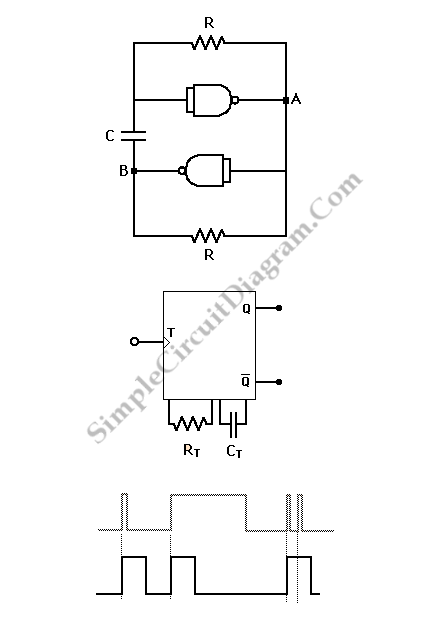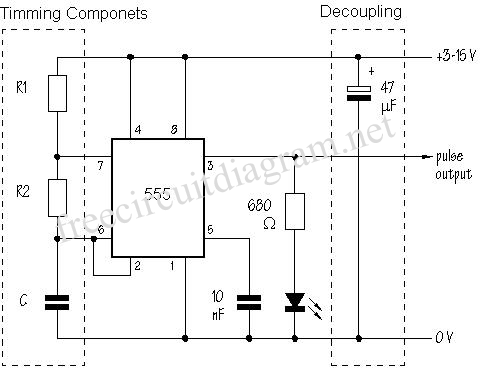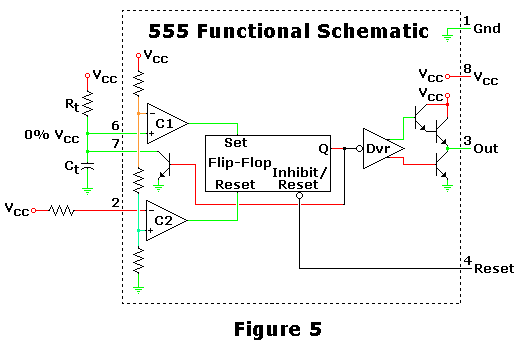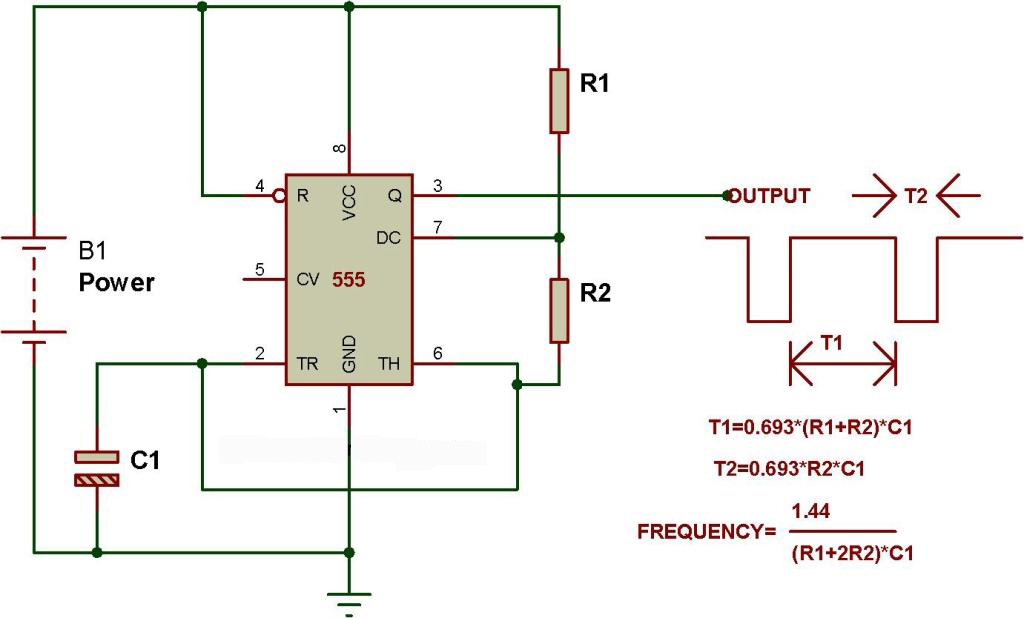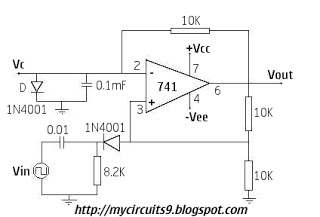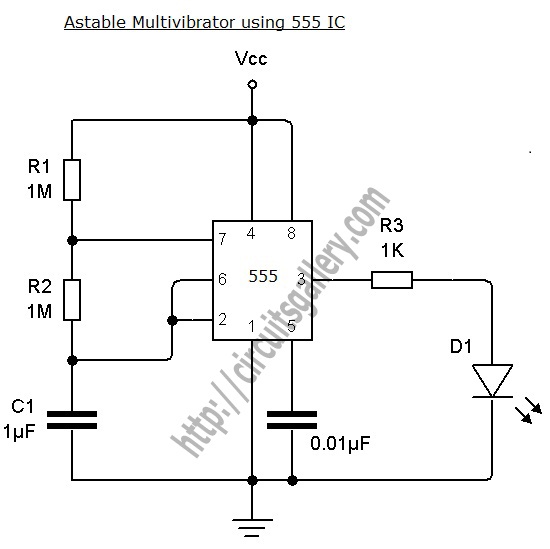
Astable multivibrator
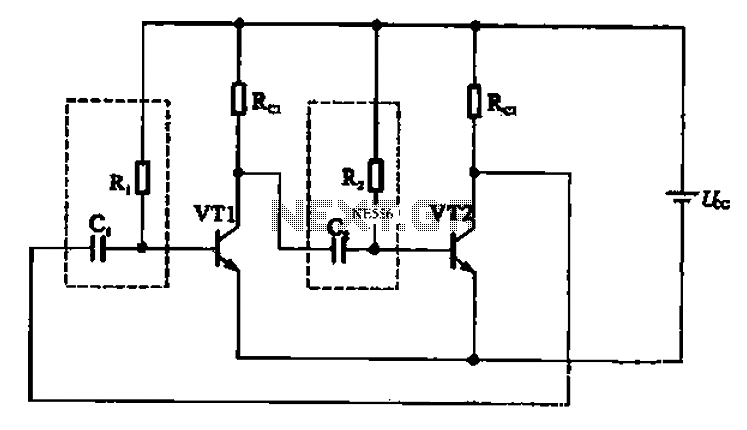
An astable multivibrator is constructed using multiple electronic components and is commonly utilized in pulse signal generation circuits. It operates as depicted in Figure 17-18. The configuration involves two transistors, VT1 and VT2, coupled to capacitor C2 and resistor Rz. The output from VT1 is sent to VT2 through coupling circuit B, which consists of components C and R, forming a positive feedback loop that enables the oscillator circuit. In the schematic, when transistor VT1 is replaced with a switch, and the coupling circuit B (C1, R1) is omitted, the circuit operates differently. In this scenario, when the switch is off, the base of VT2 receives power through R2, allowing V-12 to activate VT2. At this moment, the dashed line indicates the current path for charging capacitor C2. Once the switch is closed, the capacitor C2 is charged, resulting in the voltage dropping to zero. The moment the switch closes effectively applies a negative voltage to the base of VT2, turning it off. Subsequently, as illustrated in Figure (b), the charge discharging direction of capacitor C7 causes the base voltage of VT2 to shift from negative to positive, reactivating VT2.
The astable multivibrator circuit is an essential building block in electronic applications, primarily functioning as an oscillator to generate square wave signals. The operation of the circuit can be divided into two main phases: charging and discharging of the capacitors involved. During the charging phase, when the switch is closed, capacitor C2 begins to charge through resistor Rz, which sets up the necessary conditions for the transistors to operate in a feedback configuration. The positive feedback loop created by the coupling circuit ensures that once VT1 is turned on, it will continue to drive VT2, which in turn reinforces the conduction of VT1.
As the voltage across C2 rises, it eventually reaches a threshold level that causes the base of VT2 to become forward-biased, allowing it to conduct. This conduction leads to a rapid increase in current, which further charges C2 until it reaches a point where the feedback mechanism is disrupted, causing VT2 to turn off. The transition from conducting to non-conducting states creates the oscillation, with the time period of the oscillation being determined by the values of the resistors and capacitors in the circuit.
In practical applications, the frequency of oscillation can be adjusted by varying the resistance of Rz or the capacitance of C2. The astable multivibrator can be employed in various applications, including clock pulse generation for digital circuits, tone generation in audio devices, and timing applications in microcontroller systems. Understanding the behavior of each component in the circuit is crucial for designing effective pulse generators that meet specific frequency and duty cycle requirements. Astable multivibrator using too many electronic devices, widely used in the pulse signal generating circuit, which works as 17-18 in FIG. From the figure shows, with A coupling circuit between two transistors VT1 and VT2 to C2 and Rz way connected. The output VT2 VT1 sent out through the coupling circuit B (C, R,) form a positive feedback input, thus forming the oscillator circuit. Figure l in the transistor VT1 Sl replaced with a switch to VT1 VT2 omitted from the coupling circuit B (Ci, Rl), it now looks like Figure Figure (a) is a case of switching off sl, VT2 base from the power supply through R2 with a forward voltage, so that V-12 is turned on.
At this time, the electrical path of the dashed line is current for charging the capacitor C2. Then the switch is closed sl t in FIG. (B) in Fig. Since the capacitor C2 is charged at this time, the voltage is cut o. So switch closure moment is equivalent to VT2 base plus negative pressure, so that VT2 end. Figure (b) in the direction of the broken line is the capacitance c7, the charge discharging direction to, then VT2 base voltage changes from negative to positive, VT2 then turned on again.
The astable multivibrator circuit is an essential building block in electronic applications, primarily functioning as an oscillator to generate square wave signals. The operation of the circuit can be divided into two main phases: charging and discharging of the capacitors involved. During the charging phase, when the switch is closed, capacitor C2 begins to charge through resistor Rz, which sets up the necessary conditions for the transistors to operate in a feedback configuration. The positive feedback loop created by the coupling circuit ensures that once VT1 is turned on, it will continue to drive VT2, which in turn reinforces the conduction of VT1.
As the voltage across C2 rises, it eventually reaches a threshold level that causes the base of VT2 to become forward-biased, allowing it to conduct. This conduction leads to a rapid increase in current, which further charges C2 until it reaches a point where the feedback mechanism is disrupted, causing VT2 to turn off. The transition from conducting to non-conducting states creates the oscillation, with the time period of the oscillation being determined by the values of the resistors and capacitors in the circuit.
In practical applications, the frequency of oscillation can be adjusted by varying the resistance of Rz or the capacitance of C2. The astable multivibrator can be employed in various applications, including clock pulse generation for digital circuits, tone generation in audio devices, and timing applications in microcontroller systems. Understanding the behavior of each component in the circuit is crucial for designing effective pulse generators that meet specific frequency and duty cycle requirements. Astable multivibrator using too many electronic devices, widely used in the pulse signal generating circuit, which works as 17-18 in FIG. From the figure shows, with A coupling circuit between two transistors VT1 and VT2 to C2 and Rz way connected. The output VT2 VT1 sent out through the coupling circuit B (C, R,) form a positive feedback input, thus forming the oscillator circuit. Figure l in the transistor VT1 Sl replaced with a switch to VT1 VT2 omitted from the coupling circuit B (Ci, Rl), it now looks like Figure Figure (a) is a case of switching off sl, VT2 base from the power supply through R2 with a forward voltage, so that V-12 is turned on.
At this time, the electrical path of the dashed line is current for charging the capacitor C2. Then the switch is closed sl t in FIG. (B) in Fig. Since the capacitor C2 is charged at this time, the voltage is cut o. So switch closure moment is equivalent to VT2 base plus negative pressure, so that VT2 end. Figure (b) in the direction of the broken line is the capacitance c7, the charge discharging direction to, then VT2 base voltage changes from negative to positive, VT2 then turned on again.
